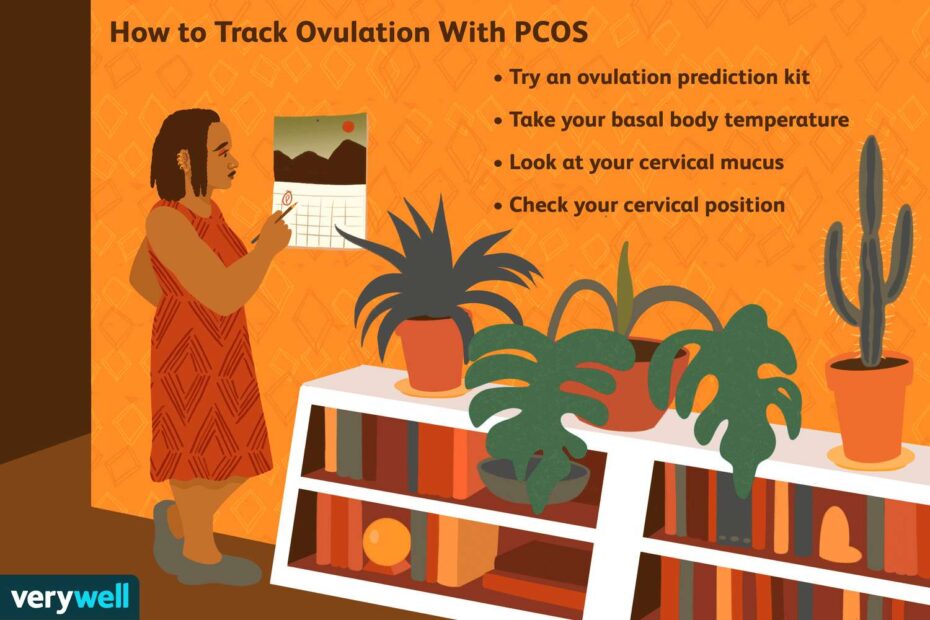Want to track your fertility? Use fertility tracking apps or devices that monitor your menstrual cycle and detect your fertile window.
These tools provide accurate data and help you track ovulation for better family planning and conception. Start tracking your fertility today for a better understanding of your reproductive health.
Understanding Your Menstrual Cycle
Understanding your menstrual cycle is essential for tracking fertility. By paying attention to changes in your body, such as basal body temperature and cervical mucus, you can predict ovulation and plan for conception.
The menstrual cycle plays a crucial role in fertility. By tracking and understanding your menstrual cycle, you can gain valuable insights into your reproductive health. In this section, we will explore the menstrual cycle in detail, including its average length, the phases it consists of, and the role hormones play in regulating this process.
Menstrual Cycle: An Overview
The menstrual cycle is a monthly occurrence experienced by women during their reproductive years. It involves a series of hormonal changes and physical processes that prepare the body for a possible pregnancy. Here’s an overview of what happens during a typical menstrual cycle:
- The menstrual cycle begins on the first day of menstruation, when the uterine lining sheds. This marks the start of a new cycle.
- Hormone levels, particularly estrogen and progesterone, fluctuate throughout the cycle, influencing various aspects of reproductive function.
- The menstrual cycle is regulated by the hypothalamus, pituitary gland, and ovaries, which work together to coordinate the release of hormones and ensure proper ovulation and menstruation.
The Role Of Hormones In Fertility
Hormones play a vital role in fertility by regulating the different phases of the menstrual cycle. Here are the key hormones involved and their functions:
- Follicle-stimulating hormone (FSH): Released by the pituitary gland, FSH stimulates the growth and development of the ovarian follicles.
- Estrogen: Produced by the developing follicles, estrogen causes the thickening of the uterine lining, promotes ovulation, and prepares the body for potential implantation.
- Luteinizing hormone (LH): A surge in LH triggers ovulation, the release of a mature egg from the ovary. This fertile window presents the best opportunity for conception.
- Progesterone: After ovulation, the ruptured ovarian follicle transforms into the corpus luteum, which produces progesterone. This hormone prepares the uterus for embryo implantation and maintains the uterine lining if fertilization occurs.
Average Length And Phases Of The Menstrual Cycle
The duration of the menstrual cycle can vary from woman to woman, but the average length is around 28 days. However, cycles between 21 and 35 days are considered normal. The menstrual cycle consists of four primary phases:
- Menstrual phase: This phase marks the start of the cycle, lasting around 3-7 days. It involves the shedding of the uterine lining, resulting in menstrual bleeding.
- Follicular phase: Following menstruation, the follicular phase begins. It spans approximately 7-14 days and involves the development of follicles in the ovaries, as well as the thickening of the uterine lining.
- Ovulatory phase: Midway through the cycle, ovulation occurs. This phase lasts around 24-48 hours and marks the release of a mature egg from the ovary, ready for fertilization.
- Luteal phase: After ovulation, the luteal phase begins, lasting around 10-16 days. If fertilization occurs, the corpus luteum continues to produce progesterone, supporting the early stages of pregnancy. If fertilization doesn’t occur, hormone levels decline, leading to menstruation and the start of a new cycle.
Understanding your menstrual cycle is key to tracking fertility and optimizing your chances of conception. By monitoring the length, phases, and hormonal patterns, you can identify potential irregularities and seek appropriate medical guidance if needed.
Charting Your Basal Body Temperature
Track your fertility by charting your basal body temperature. Monitoring your body temperature can help you determine the most fertile days of your menstrual cycle.
Tracking your basal body temperature (BBT) is a crucial aspect of fertility monitoring. By charting your BBT, you can gain valuable insights into your menstrual cycle and identify the most fertile days for conception. Here’s how you can effectively track your BBT:
Preparing And Using A Bbt Thermometer
To chart your BBT accurately, you will need a specialized basal body temperature thermometer. Follow these steps to prepare and use it correctly:
- Purchase a BBT thermometer: Look for a digital thermometer specifically designed for tracking BBT. These thermometers provide precise readings, making them ideal for fertility tracking.
- Use it consistently: Start using your BBT thermometer on the first day of your menstrual cycle to establish a consistent routine. Take your temperature every morning before getting out of bed, at the same time each day.
- Choose a reliable method: You can use either an oral or vaginal method to measure your BBT. Select the method that suits you best and be consistent throughout your tracking period.
- Get sufficient sleep: To ensure accurate readings, try to get a good night’s sleep before taking your temperature. Adequate rest helps stabilize your BBT, providing more reliable data.
- Take your temperature correctly: When using an oral thermometer, place it under your tongue for around three minutes. For the vaginal method, insert the thermometer about an inch into your vagina and leave it for the required duration. Note down the reading on your BBT chart.
Interpreting Bbt Chart Patterns
Once you have recorded your daily BBT readings, it’s time to interpret the patterns on your BBT chart. Here are a few key points to consider:
- Look for changes in temperature: Pay attention to subtle shifts in your BBT over the course of your menstrual cycle. Generally, you’ll notice a slight temperature rise after ovulation.
- Identify the temperature shift: After ovulation, your BBT may increase by around 0.5 to 1 degree Fahrenheit. This temperature shift indicates that you have passed your fertile window and are entering the luteal phase of your cycle.
- Detect patterns in your chart: By observing your BBT patterns over several months, you can identify recurring trends unique to your cycle. This will help you predict future ovulation and plan accordingly.
- Consider additional fertility signs: BBT tracking is most effective when combined with other fertility signs, such as cervical mucus changes and ovulation predictor kits. Monitoring multiple indicators enhances the accuracy of your fertility predictions.
- Seek expert advice: If you’re having difficulty interpreting your BBT chart or need guidance, consult an experienced healthcare professional or fertility specialist. They can provide personalized insights and help you make informed decisions.
Charting your basal body temperature gives you a deeper understanding of your fertility and dramatically increases your chances of conceiving. By following these guidelines, you’ll be well-equipped to track your BBT effectively and utilize the valuable information it provides. Remember, consistency and accurate record-keeping are key to success.
Monitoring Cervical Mucus Changes
Track your fertility by monitoring cervical mucus changes. This method allows you to easily identify your most fertile days without relying on ovulation prediction kits or apps.
Importance Of Cervical Mucus In Fertility Tracking
- Cervical mucus plays a crucial role in fertility tracking as it provides valuable insights into a woman’s menstrual cycle. Understanding the changes in cervical mucus can help identify the most fertile and non-fertile periods, aiding in the achievement or prevention of pregnancy.
- Monitoring cervical mucus can offer a cost-effective and natural alternative to other fertility tracking methods, providing valuable information for couples trying to conceive or avoid pregnancy.
Types And Consistency Of Cervical Mucus Throughout The Menstrual Cycle
- Dry: During the early part of the menstrual cycle, the cervix produces minimal mucus, resulting in a dry sensation.
- Sticky: As the cycle progresses, the cervix starts producing sticky and dense mucus. It may feel tacky or pasty.
- Creamy: Closer to ovulation, cervical mucus becomes creamy and lotion-like in consistency. It is usually white or off-white, and may be more abundant.
- Egg white: The most fertile phase of the menstrual cycle is characterized by cervical mucus resembling raw egg whites. It is clear, stretchy, and slippery, facilitating sperm transportation.
- Watery: After ovulation, cervical mucus becomes more watery and may appear transparent. It may be less abundant than during the egg white phase.
- Dry again: As the menstrual cycle comes to an end, cervical mucus production decreases, resulting in a dry sensation once again.
Observing And Recording Cervical Mucus Changes
- To monitor cervical mucus changes, it is important to observe and record daily observations. Here are some steps to follow:
- Wash your hands thoroughly before checking your cervical mucus.
- After inserting your index or middle finger into your vagina, observe the consistency and color of the mucus.
- Note the texture, viscosity, and any changes in the mucus on a fertility tracking chart or app.
- Pay attention to changes in sensation, such as dryness, stickiness, or lubrication.
- Be consistent with your observations, ideally checking at the same time each day.
- Remember that factors like hormonal fluctuations, medication, or sexual activity can influence cervical mucus, so it’s important to record any relevant information alongside your observations.
By keeping track of your cervical mucus changes throughout your menstrual cycle, you can enhance your understanding of your fertility patterns and increase your chances of achieving or avoiding pregnancy.
Utilizing Ovulation Predictor Kits (Opks)
Learn how to track your fertility with the help of ovulation predictor kits (OPKs). These kits enable you to identify your most fertile days accurately and increase your chances of conceiving.
What Are Ovulation Predictor Kits (Opks)?
- Ovulation Predictor Kits (OPKs) are tools commonly used by women to track their fertility and predict the most fertile days of their menstrual cycle.
- These kits come in various forms, such as urine-based tests or digital monitors, and are easily available over the counter at pharmacies or online.
- OPKs detect luteinizing hormone (LH) levels in the urine, which surge approximately 24 to 36 hours before ovulation occurs.
- By indicating when ovulation is imminent, OPKs can help couples time intercourse to increase their chances of conception.
How Do Opks Work?
- OPKs work by detecting the LH surge in a woman’s urine, which occurs shortly before ovulation.
- When a woman’s body releases an egg, the pituitary gland in her brain produces a surge of LH.
- LH stimulates the release of the egg and helps prepare the body for potential pregnancy.
- OPKs utilize test strips or digital monitors to detect the presence of LH in urine samples.
- The test strips or monitors provide results that indicate whether or not the LH surge has occurred, signaling the onset of ovulation.
Tips For Accurate Opk Testing And Interpretation:
- Start testing your urine a few days before the predicted date of ovulation, which is typically halfway through your menstrual cycle.
- Follow the instructions included with the OPK carefully to ensure accurate results.
- Test your urine at the same time each day, as LH levels can vary throughout the day.
- Avoid excessive fluid intake before testing, as it can dilute the urine and affect the accuracy of the results.
- Be patient and consistent with OPK testing, as it may take a few cycles to understand your individual patterns.
- Remember that OPKs only predict ovulation, and do not guarantee fertility or pregnancy.
- Interpret the results of OPKs based on the manufacturer’s instructions and the appearance of the test line relative to the control line.
- Keep in mind that some factors, such as certain medications or medical conditions, can affect the accuracy of OPK results.
- Consider tracking other signs of fertility, such as changes in cervical mucus or basal body temperature, alongside OPK testing for a more comprehensive understanding of your fertility patterns.
- Consult with a healthcare professional if you have concerns about your fertility or are experiencing difficulties conceiving.
Remember, understanding and tracking your fertility can help you maximize your chances of conception and achieve your family planning goals. Utilizing ovulation predictor kits (OPKs) is one effective method to gain insights into your fertility window and optimize your timing for conception.
With the proper understanding and interpretation of OPK results, you can increase your chances of successfully conceiving. Happy tracking!
Recognizing Ovulation Symptoms
Learn how to track your fertility by recognizing ovulation symptoms. By paying attention to changes in your body like cervical mucus, basal body temperature, and abdominal pain, you can pinpoint the best time for conceiving.
Common Signs And Symptoms Of Ovulation:
- Increased cervical mucus: During ovulation, the consistency of cervical mucus changes, becoming thin, slippery, and clear. This type of mucus helps sperm reach the egg more easily.
- Mild pelvic pain or discomfort: Many women experience mild pain or discomfort in the lower abdomen during ovulation. This sensation is often referred to as mittelschmerz.
- Breast tenderness: Some women may notice that their breasts become more sensitive or tender during ovulation.
- Increased sex drive: Hormonal changes during ovulation can boost sex drive in some women.
- Basal body temperature (BBT) rise: Monitoring your basal body temperature can help you identify ovulation. After ovulation, there is a slight increase in BBT due to the release of progesterone.
Observing Changes In Cervical Position:
- Softening of the cervix: During ovulation, the cervix tends to become softer and may rise higher in the vagina. You can check for changes in cervical position by inserting a clean finger and feeling for these differences.
- Opening of the cervix: The cervix typically opens slightly during ovulation as hormones prepare the body for potential fertilization. Using clean hands, you can feel for this opening to determine if ovulation is occurring.
Other Signs That Indicate Ovulation Is Occurring:
- Light spotting: Some women may experience light spotting or small amounts of bleeding during ovulation. This is known as ovulation spotting and is considered normal for some individuals.
- Abdominal bloating: Hormonal changes can cause water retention and bloating during ovulation.
- Increased sense of smell: A heightened sense of smell is sometimes reported during ovulation due to changes in hormone levels.
Remember, it’s important to keep track of these signs and symptoms over multiple cycles to accurately identify patterns and confirm ovulation. By recognizing ovulation symptoms, you can better understand your fertility and increase your chances of conception.
Tracking Menstrual Cycle Length And Regularity
Track your fertility by monitoring the length and regularity of your menstrual cycle. Understanding these patterns can help you identify your most fertile days and increase your chances of conceiving. Stay informed and take control of your reproductive health.
One of the key aspects of tracking fertility is keeping a close eye on your menstrual cycle length and regularity. Understanding your cycle can provide valuable insights into your fertility and help you plan for conception. In this section, we’ll explore how to calculate menstrual cycle length, the reasons for irregular or unpredictable cycles, and how tracking cycle length can aid fertility awareness.
How To Calculate Menstrual Cycle Length:
To calculate your menstrual cycle length, follow these steps:
- Start counting from the first day of your period.
- Continue counting until the first day of your next period.
- Note down the number of days between these two dates.
- Repeat this process for several cycles to establish an average cycle length.
Understanding your cycle length is important because it can provide information about when you are most likely to ovulate, the fertile window, and the best time to try to conceive.
Reasons For Irregular Or Unpredictable Cycles:
Irregular or unpredictable cycles can be caused by various factors. Here are some common reasons:
- Hormonal imbalances: Fluctuations in hormone levels can cause irregular cycles.
- Stress: High levels of stress can disrupt the normal functioning of the reproductive system.
- Polycystic ovary syndrome (PCOS): This condition can lead to irregular periods and difficulty in conceiving.
- Thyroid disorders: Thyroid issues can affect menstrual regularity.
- Obesity or excessive weight loss: Drastic changes in weight can disrupt hormone production and affect the menstrual cycle.
How Tracking Cycle Length Can Aid Fertility Awareness:
Tracking your cycle length can help you in the following ways:
- Identifying ovulation: By understanding your cycle length, you can pinpoint the most fertile days when ovulation is likely to occur.
- Determining luteal phase length: The luteal phase is the time between ovulation and the start of the next period. Knowing this length can help you identify any abnormalities or potential issues.
- Predicting fertile window: By tracking your menstrual cycle length, you can estimate your fertile window, which is the period most conducive to conception.
- Seeking medical advice: If your cycle length is consistently irregular or significantly deviates from the average, it may be an indication of an underlying fertility issue. Tracking can help you gather accurate information to share with a healthcare provider.
Tracking your menstrual cycle length and regularity is an essential part of fertility awareness. By understanding the length of your cycle, you can identify ovulation, predict the fertile window, and seek medical advice if needed. Stay tuned for the next section, where we’ll explore tracking basal body temperature for fertility awareness.
Using Fertility Apps And Online Tools
Track your fertility with the help of fertility apps and online tools. These user-friendly resources provide an easy and convenient way to monitor your reproductive health and increase your chances of conception.
Overview Of Fertility Tracking Apps
- Fertility tracking apps and online tools have revolutionized the way women monitor and understand their menstrual cycle and fertility. These handy applications provide a user-friendly interface that allows individuals to easily track their fertility and gain insights into their reproductive health.
- With the abundance of apps available, it’s important to choose one that suits your preferences and requirements. From basic period tracking to in-depth fertility predictions, these apps offer a wide range of features to cater to different needs.
- Integrating fertility tracking apps into your daily routine can empower you with knowledge about your menstrual cycle, ovulation, and chances of conceiving. Let’s delve deeper into the features to look for in a fertility app or online tool.
Features To Look For In A Fertility App Or Online Tool
- User-friendly interface: Look for an app that is intuitive and easy to navigate, allowing you to input data effortlessly. The interface should be visually appealing and provide a seamless user experience.
- Accurate prediction algorithms: The app’s ability to accurately predict fertile windows and ovulation is crucial for those trying to conceive. Look for apps that utilize advanced algorithms based on scientific research for reliable predictions.
- Menstrual cycle tracking: A good fertility app should offer comprehensive menstrual cycle tracking, allowing you to record start and end dates, flow intensity, and any unusual symptoms or fluctuations.
- Basal body temperature (BBT) tracking: BBT tracking can provide valuable insights into your fertile window. The app should allow you to easily record your daily BBT, graphically display the data, and provide interpretations.
- Cervical mucus observations: Cervical mucus changes throughout your menstrual cycle, and tracking these changes can assist in predicting ovulation. A fertility app should enable you to record and analyze your cervical mucus observations.
- Fertility charting: Look for apps that provide clear and informative charts to help you visualize your menstrual cycle and fertility patterns. These charts can assist in recognizing trends and identifying potential issues.
- Reminder notifications: Choose an app that offers reminder notifications for period tracking, ovulation predictions, and other relevant events. These reminders can ensure that you don’t miss any important data.
- Integration with wearable devices: Some apps can sync and integrate data from wearable devices like fitness trackers or smartwatches, providing a more holistic overview of your reproductive health.
- Data export and sharing capabilities: If you’re working with a healthcare provider or sharing information with a partner, opt for an app that allows you to export your data easily or grant access to multiple users.
- Community support and resources: Many fertility apps offer a supportive community where individuals can connect, share experiences, and gain valuable insights. Look for apps that provide access to a community forum or educational resources.
By utilizing a fertility tracking app or online tool that aligns with your needs, you can gain a deeper understanding of your reproductive health and enhance your chances of conceiving. Remember, finding the right app is key to effectively track your fertility and embark on your journey towards parenthood.
Incorporating Additional Methods For Fertility Tracking
Learn effective ways to track your fertility by incorporating additional methods. Discover new techniques to enhance your understanding of your menstrual cycle and increase your chances of conceiving.
Cervical Position Tracking
- Tracking your cervical position is a useful method for determining your fertility levels. Here are some key points to keep in mind:
- The position of your cervix changes throughout your menstrual cycle. Observing these changes can help you identify when you’re most fertile.
- To track your cervical position, make sure your hands are clean and insert a finger into your vagina to feel for your cervix. Take note of its position, height, and texture.
- During ovulation, the cervix is typically higher, softer, and more open. As you approach menstruation, it will lower, become firmer, and closer.
- By monitoring these changes over a few months, you can establish patterns and better understand your fertile window.
- Keep a journal or use a fertility tracking app to record your observations and identify trends in your cervical position. This can help you plan intercourse for optimal chances of conception.
Saliva Ferning And Microscope Monitoring
- Saliva ferning and microscope monitoring are additional methods that can enhance your fertility tracking journey. Here’s what you need to know:
- Saliva ferning refers to the unique pattern that appears when dried saliva is observed under a microscope during your fertile days.
- Purchase a fertility microscope kit designed specifically for saliva ferning. Follow the instructions to collect a saliva sample and allow it to dry on the slide provided.
- Once dried, use the microscope to examine the saliva. If you see a fern-like pattern, it indicates high levels of estrogen, indicating an increased chance of fertility.
- Monitoring your saliva ferning patterns daily can help predict your fertile window and guide your timing for intercourse.
- Similarly, using a microscope to track changes in your cervical mucus can provide valuable insights into your fertility. As you approach ovulation, cervical mucus becomes clear, stretchy, and slippery, resembling egg whites.
- Regularly check and observe your cervical mucus under the microscope to identify these changes. This method can offer an additional confirmation of your fertile days.
Hormone Monitoring Through Urine Or Blood Tests
- Monitoring your hormone levels through urine or blood tests is a more scientific approach to fertility tracking. Here are the key details:
- Hormone monitoring involves measuring the levels of hormones like luteinizing hormone (LH) and progesterone in your body. These hormones play crucial roles in regulating your menstrual cycle and fertility.
- Urine tests, commonly known as ovulation prediction kits (OPKs), detect the surge in LH levels that occurs before ovulation. By tracking this surge, you can identify your most fertile days.
- Blood tests, conducted by healthcare professionals, provide more accurate and comprehensive hormone level results. They can help diagnose any hormonal imbalances or conditions that may hinder fertility.
- Hormone monitoring is particularly beneficial for individuals with irregular cycles or specific fertility concerns. Consulting a healthcare professional can guide you in choosing the right tests and interpreting the results.
- Remember, hormone testing alone may not provide a complete picture of your fertility. Combining it with other methods like cervical position tracking and cervical mucus monitoring can offer a more comprehensive view.
Identifying Potential Fertility Issues
Learn how to track your fertility and identify potential issues with these expert tips. Discover the best methods and techniques to stay on top of your reproductive health for a smoother journey towards parenthood.
Understanding the factors that could potentially impact fertility is an important step for individuals and couples trying to conceive. Identifying potential fertility issues early on can help you seek medical help and explore appropriate treatment options. In this section, we will discuss common causes of infertility, when to seek medical help, and additional tests and evaluations for fertility concerns.
Common Causes Of Infertility:
- Age-related factors: Women’s fertility declines with age, especially after the age of 35. Advanced maternal age increases the risk of infertility and complications during pregnancy.
- Ovulation disorders: Irregular or absent ovulation can make it challenging to conceive. Conditions such as polycystic ovary syndrome (PCOS) and hypothalamic dysfunction can affect ovulation.
- Structural abnormalities: Structural issues like blocked fallopian tubes or uterine abnormalities can hinder successful conception.
- Sperm-related issues: Male factor infertility can be caused by low sperm count, poor sperm quality, or issues with sperm motility.
- Endometriosis: This condition occurs when the tissue lining the uterus grows outside of it. Endometriosis can lead to infertility due to the formation of scar tissue.
When To Seek Medical Help:
It’s important to seek medical help if you’re experiencing any of the following:
- Trying to conceive for over a year (or six months for women over 35) without success.
- Irregular or absent menstrual cycles.
- Painful periods.
- Known conditions that can affect fertility, such as PCOS or endometriosis.
- Previous miscarriages or known fertility issues.
Additional Tests And Evaluations For Fertility Concerns:
If you suspect a fertility issue, your healthcare provider may recommend the following tests and evaluations:
- Hormone level testing: Blood tests to assess hormone levels, including follicle-stimulating hormone (FSH), luteinizing hormone (LH), and progesterone.
- Ovulation evaluation: Monitoring basal body temperature, tracking menstrual cycles, or performing ultrasound scans to assess ovulation.
- Semen analysis: Testing the quality and quantity of sperm through a semen analysis.
- Hysterosalpingography: An X-ray procedure to evaluate the shape of the uterus and check for blockages in the fallopian tubes.
- Laparoscopy: A surgical procedure to examine and treat conditions such as endometriosis or blocked fallopian tubes.
By identifying potential fertility issues, you can take proactive steps towards seeking medical help and exploring appropriate treatment options. Remember, it’s essential to consult with a healthcare professional to receive personalized guidance and support on your fertility journey.
Creating A Fertility Tracking Plan
Learn how to effectively track your fertility by creating a customized fertility tracking plan. Gain valuable insights and increase your chances of conceiving with this step-by-step guide.
Determining Your Fertility Goals:
- Understand your personal goals: Before starting your fertility tracking journey, take some time to think about what you hope to achieve. Are you aiming for pregnancy or simply trying to understand your cycle better? Knowing your goals will help shape your tracking plan.
Developing A Personalized Tracking Routine:
- Charting your menstrual cycle: Start by tracking the length of your menstrual cycle. This will help you determine when you are most likely to ovulate and be fertile.
- Monitoring basal body temperature: Tracking your basal body temperature (BBT) can provide valuable insights into your fertility. Measure your temperature each morning before getting out of bed and record it in a fertility tracking app or on a chart.
- Checking cervical mucus changes: Pay attention to changes in your cervical mucus throughout your menstrual cycle. The consistency and appearance of your cervical mucus can indicate when you are approaching ovulation and are most fertile.
- Using ovulation predictor kits (OPKs): OPKs can help you predict when ovulation is about to occur by detecting the surge in luteinizing hormone (LH) that happens before ovulation. Use them in addition to other tracking methods for more accuracy.
- Tracking other signs and symptoms: Some women also track other symptoms like breast tenderness, abdominal cramping, or mood changes that can provide additional clues about their fertility.
- Maintaining consistent tracking: It is important to maintain a consistent routine when tracking your fertility. This means tracking your temperature, cervical mucus, and other signs every day, ideally at the same time each day.
Factors To Consider When Planning For Conception:
- Age and overall health: Age and general health can affect fertility. Women in their late 30s or 40s may have more difficulty conceiving, and certain health conditions can impact fertility as well.
- Lifestyle factors: Consider your lifestyle habits, such as smoking, alcohol consumption, and exercise levels. These factors can influence fertility and should be taken into account when planning for conception.
- Timing intercourse: Understanding your ovulation window is crucial for timing intercourse. Aim to have sex in the days leading up to and including your ovulation day to maximize your chances of conception.
- Seeking medical advice: If you have been actively tracking your fertility for several months without success, it may be beneficial to consult a healthcare professional. They can offer guidance, perform necessary tests, and provide fertility treatment options if needed.
- Emotional well-being: Trying to conceive can be emotionally challenging. Take care of your emotional well-being by seeking support from your partner, friends, or support groups. Consider practicing stress-reducing activities like meditation or yoga.
Remember, each person’s fertility journey is unique. By determining your fertility goals, developing a personalized tracking routine, and considering relevant factors, you can optimize your chances of conceiving while also gaining a better understanding of your fertility.
Best Practices For Fertility Tracking
Discover the best practices for fertility tracking and learn how to effectively track your fertility for better family planning and reproductive health.
Tracking fertility can be a complex and emotional journey for individuals and couples who are trying to conceive. It requires consistency, patience, and a willingness to adapt. To help you navigate this process, here are some best practices for fertility tracking:
Consistency And Accuracy In Tracking Methods:
- Utilize a single method: Choose a tracking method that aligns with your preferences and lifestyle. Consistency is key for accurate results.
- Basal Body Temperature (BBT): Measure your BBT every morning before getting out of bed. Chart the temperature changes throughout your menstrual cycle to identify patterns.
- Cervical mucus monitoring: Observe the changes in your cervical mucus to determine the fertile and non-fertile phases of your cycle.
- Ovulation predictor kits (OPKs): Use OPKs to detect the surge in luteinizing hormone (LH), which occurs before ovulation. This can help you pinpoint your most fertile days.
Staying Patient And Managing Stress:
- Manage stress levels: High stress levels can negatively impact fertility. Find healthy ways to cope with stress, such as practicing mindfulness, exercising, or seeking support from loved ones.
- Patience is key: Remember that tracking fertility takes time. It may take a few months to understand your unique patterns and cycles. Stay patient and trust the process.
- Communicate with your partner: Openly discuss your emotions and concerns with your partner. Create a support system that allows for open communication and understanding throughout the fertility tracking journey.
Continuous Learning And Adapting The Tracking Approach:
- Stay informed: Keep yourself updated on the latest research and advancements in fertility tracking methods. Stay connected with online communities and fertility experts to gain insights and support.
- Take notes and track changes: Maintain a fertility journal to record any changes or observations throughout your cycle. Tracking these details can help you identify trends and patterns over time.
- Be open to adapting: If you’re not seeing the desired results, be open to trying different tracking methods or seeking professional help. Each individual’s fertility journey is unique, and what works for someone else may not work for you. Stay open-minded and willing to adapt your approach.
By following these best practices for fertility tracking, you can enhance your chances of understanding your menstrual cycle, identifying your most fertile days, and ultimately increasing the likelihood of conception. Remember, each step you take brings you closer to your goal of building a family.
Stay consistent, patient, and open to learning along the way.

Credit: www.gayparentstobe.com
Frequently Asked Questions For How To Track Fertility
How Do You Track When You Are Fertile?
To track your fertility, use methods like tracking your menstrual cycle, observing changes in cervical mucus, and using ovulation predictor kits.
How Many Days After Period Are You Fertile?
You are most fertile around 14 days after the start of your period.
Are You Fertile On Your Period?
No, you are not fertile during your period.
How Can I Track My Fertility?
Tracking your fertility can be done by monitoring your menstrual cycle, tracking basal body temperature, using ovulation prediction kits, or using smartphone apps designed for fertility tracking. These methods can help you identify your most fertile days and increase your chances of conceiving.
Conclusion
Tracking fertility is crucial for couples trying to conceive or those who want to better understand their reproductive health. By using various methods such as tracking menstrual cycles, monitoring basal body temperature, and observing changes in cervical mucus, individuals can gain valuable insights into their fertile window.
This knowledge can significantly increase the chances of successful conception. Additionally, technological advancements have made fertility tracking more accessible and convenient. Mobile apps and wearable devices provide personalized insights and reminders, making the process easier and more accurate. However, it is essential to remember that fertility tracking methods are not foolproof, and consulting with a healthcare professional is always advisable.
By staying informed about your fertility and understanding how to track it effectively, you can take control of your reproductive health and make informed decisions about family planning. Start tracking your fertility today and embark on the exciting journey of creating a family or managing your fertility health.
- What Is the 11 Hour Limit: A Comprehensive Guide - June 7, 2024
- What Happens if You Drive on a Suspended License in Virginia - June 7, 2024
- Wilcox Justice Court Overview: Online Services & Legal Proceedings - June 6, 2024




